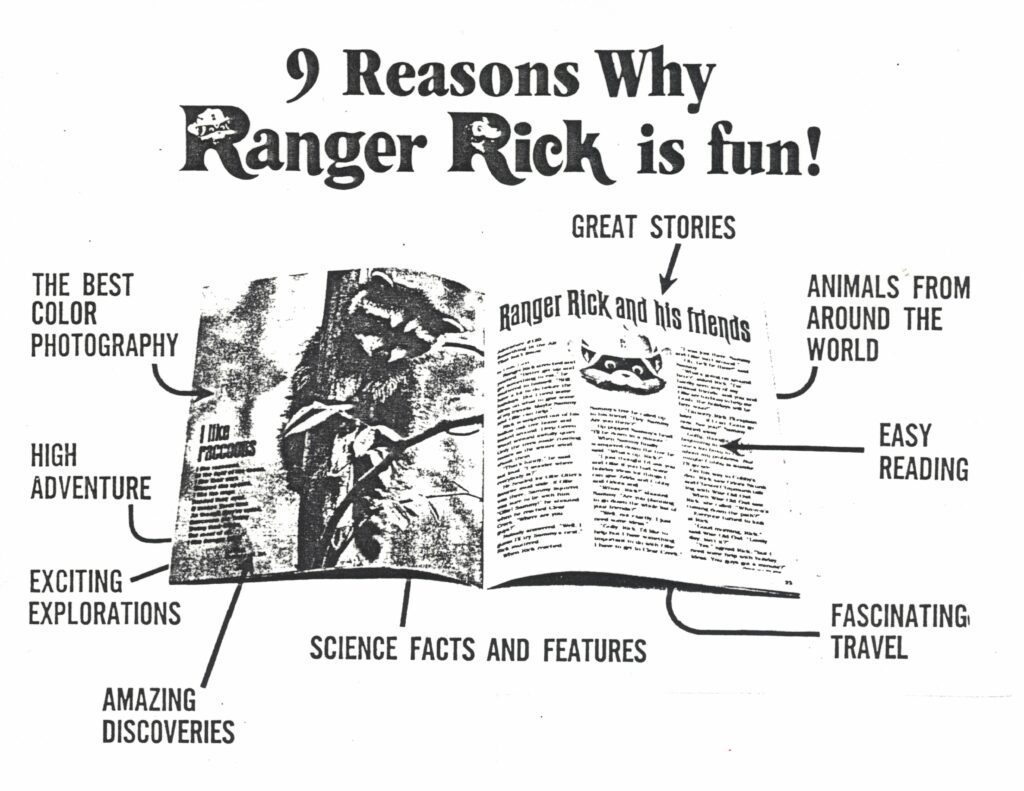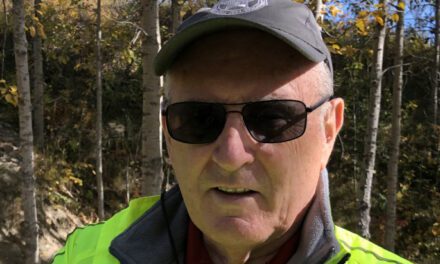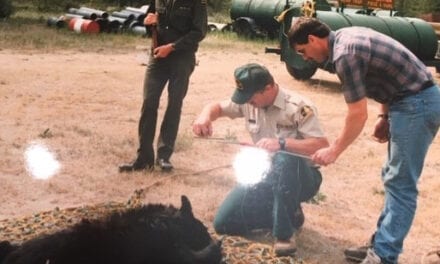It’s funny, I don’t see many Park personnel in the backcountry anymore, and I do a lot of hiking. Trail crew are carrying pulaskis and chain saws, but they do not rebuild the water bars and secure erosion. The trails have been eroding ever since the 1980s. The flood in 2013 really made a lot of damage to the trail system. They haven’t gone back to try and build up the erosion that’s happening everywhere. I don’t think people have the same feel for it like in the old days. Cabins aren’t being used regularly, and there’s little sign of use in remote areas.
MH: What about the Warden Service was important to you? 1:06:01:
RK: The lifestyle and the natural progression, the pendulum going back and forth, the populations going up and down, and trying to leave it as minimal impact on the systems that were changing around us. I never agreed with Cliff White, the big intense burns in the summertime, because I don’t think it ever happened that way. There were lots of small burns. And I could get behind that. When the Indians burned, they didn’t have humongous burns. They didn’t have helicopters in those days and they couldn’t make these big burns. So everything happened on a more human scale. When I was in the Warden Service, life was on a human scale, except that in Public Safety, we were responding to demand from the public. I used to call it the overprotected consumer. I thought, if somebody is going to put a new route up an extreme face and they get into trouble, why should we be expected to risk our lives to retrieve them. They’ll become legends; they’ll name the route after them if they’re hanging up there, and they’re becoming skeletons. And why do we have to go and get all of them? we’ll get most of them, but not the ones that are really risking all for the sake of just putting up a new route. I mean, we’ve had lots of rescues in Johnson’s Canyon, people sprained an ankle. And in the early days, we’d go in with the wheeled deer toter and do the rescue. The rescue books said it took a lot of manpower and a lot of time so they preferred to use a helicopter.
There were a lot of little rescues and it was group work. A famous early heli rescue was in 1970 at Lake Louise. Jim Davies slung Billy Vroom and Monte Rose up to the Three / Four Couloir late in the day to recover an injured climber. Those guys were out of their element, Billy was essentially a cowboy trained by Walter Perrin and Monte was Area Manager at the time. But he answered the phone at the wrong time and had to help. They were up there overnight dodging rocks and icefalls. Davies came back in the morning to sling them off, but he too was pushing previous limits.
I guess with Jim flying better and better and all these other pilots coming in who were real hot shots. They were willing to go farther and do more. Tim Auger and Claire Israelson kept taking on bigger challenges.
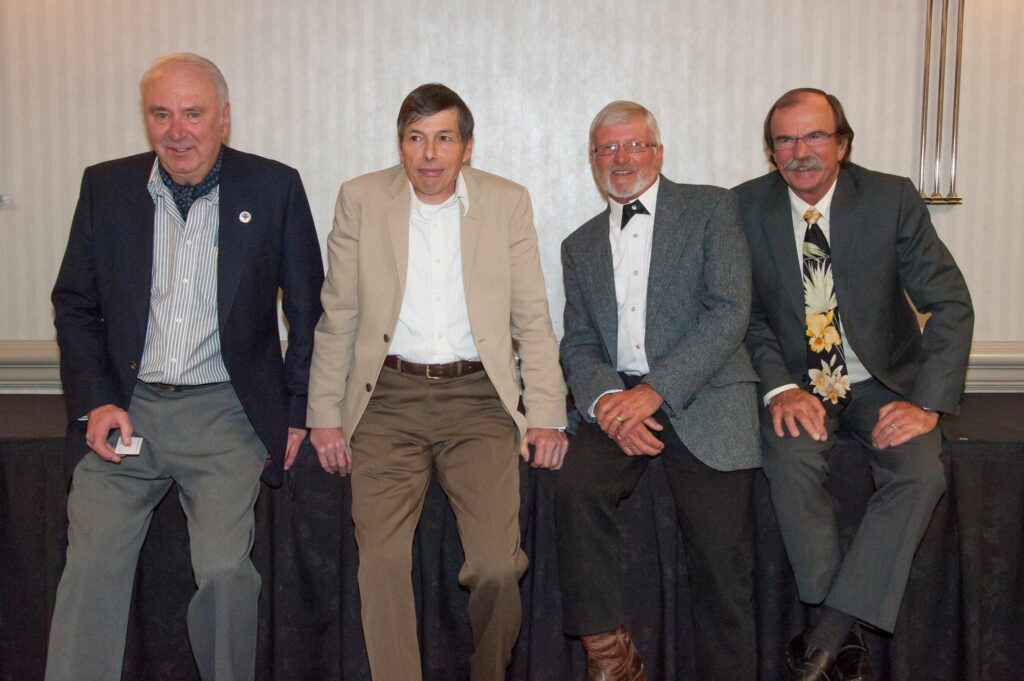
Guides Ball 2013 Jim Davies, Tim Auger, Lance Cooper, Rick Kunelius
MH: Are there any legendary characters or stories associated with the Warden Service that you can share?
RK: Andy Anderson, because he was such a character. I thought he was a hell of a good Chief Park Warden because he used to communicate with everybody. We had more meetings and more regional schools and everybody got together on the same page. And Jim Vollmershausen the Superintendent, and he was visible. Some of these superintendents weren’t visible, but Jim did some fun things. When we had the beaver fever here, and we had to trap all the beavers out of 40 Mile Creek, they put the big water reservoir on Tunnel Mountain. Dr. Priscilla Wilson was the chief medical officer and was determined to get the water reservoir. Once it was built, and all the rest of it, the Vollmershausen and I got together and named the whole place “Priscilla’s Pond”. We had a grand opening with a big sign there and gave her a frozen beaver. He was the last superintendent with a real sense of humor.
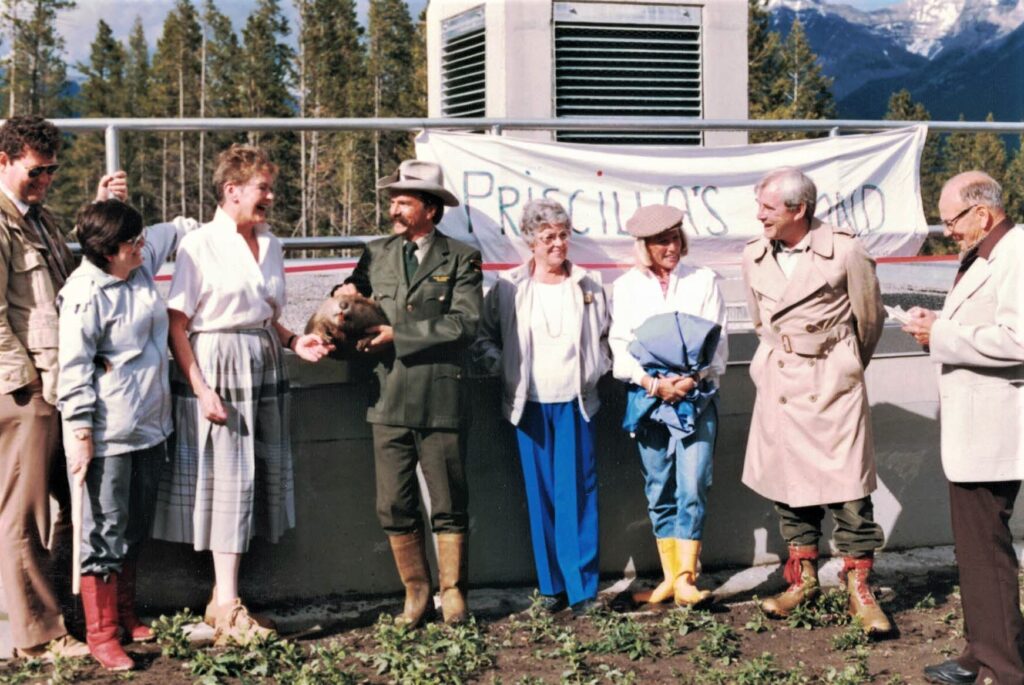
Priscilla’s Pond Grand Opening
I got to know Harry Dempster, who’d been Superintendent way before my time. He was responsible for all of the western Parks out of the Banff Administration Building, back before regional office was created in Calgary. He was an engineer to begin with and had surveyed middle sections of the Banff Jasper highway during construction in the thirties. In Banff, people walked in fear of Dempster, because he was tough and determined. Men did it his way. But everything was done and the trails were built and a lot of progress was made. I first met him when I was called over to deal with the wasps in his garbage container. We had mutual friends and we ended up partying and skiing together at Norquay. It was great fun to ski with Dempster, Frank Gourlay, Bruno Engler, George Ram and others from that era.
Johnny Prestoff, who was ski instructor for years, and then he fell down the stairs at the Voyageur and had a bit of brain damage, and he was a janitor for us. But we all skied together and then in the later years when Wackerle came back and skied. Prestoff, Wackerle and I would go up to Norquay, and John would always say, “Okay, Prestoff is getting tired, one of us has to go back to the lodge with him.” And I’d go, “What do you mean, one of us has to go? If he falls, he’s like a turtle. He can’t get up again.” And he did fall one time when some little kid clipped him. He ended up on his back the skis up in the air, and he couldn’t get up. Needless to say, we were there to help. I am hoping that someone be watching for me when I end up in that position.
MH: Is there anything about the Warden Service, as you knew it, that you would like future generations to know? 1:14:00: That it wasn’t always like it is now. It was quite different. They’ll never know what freedom we used to have. And we all took it seriously. We worked hard, but we enjoyed what we’re doing, we did the best we could always. Jack of all trades and master of none.
MH: What made the Warden Service such a unique organization?
RK: Diversity towards a common goal. So many characters from different directions but we were all headed the same way. The public was allowed to come into our office, they’d ask what conditions were like in a specific backcountry area, and inevitably, someone in the office had been there recently and could respond. It was the golden years for us and also the public. Interaction between the two. Authors were writing books (Don Beers) and he’d pop in for a visit and we could exchange info. And when Bart (Robinson) and Brian (Patton) wrote the big trail guide, lots of wardens helped out and there was always support for those projects.
MH: Do you have any lasting memories as a Warden?
RK: I still see Wackerle a lot and Monte Rose a couple of times a year. Lance Cooper and Tim Auger are both gone. Peter Furman I run into once in a while and he’s still as strong as can be. He’s building a stone wall for somebody now, he had eight tons of rock brought in. I think we talked about a lot of people off and on all the way through. I just wrote in here, Bud Brewster, Ron Warner, Hubert Green. I didn’t really know Hubert Green, but I had a lot of his notes from the archives at the Whyte Museum. Jimmy Deegan was dispatcher for the Warden Service and he had a comprehensive Park background, although he never made promotion to a full warden. He was a Banff local and he used to pack on skis to Skoki Lodge for Lizzie Rummel, before serving in the navy during the war. He had a photographic memory. Once on night shift I told him I had to patrol to Indian Head but I’ve never been there. He proceeded to give me detailed directions, and named many of the features along the way. I did my best to remember his directions. Fortunately, I ended up with Jimmy Rimmer’s horses, they knew where to go when I went to Indian Head.
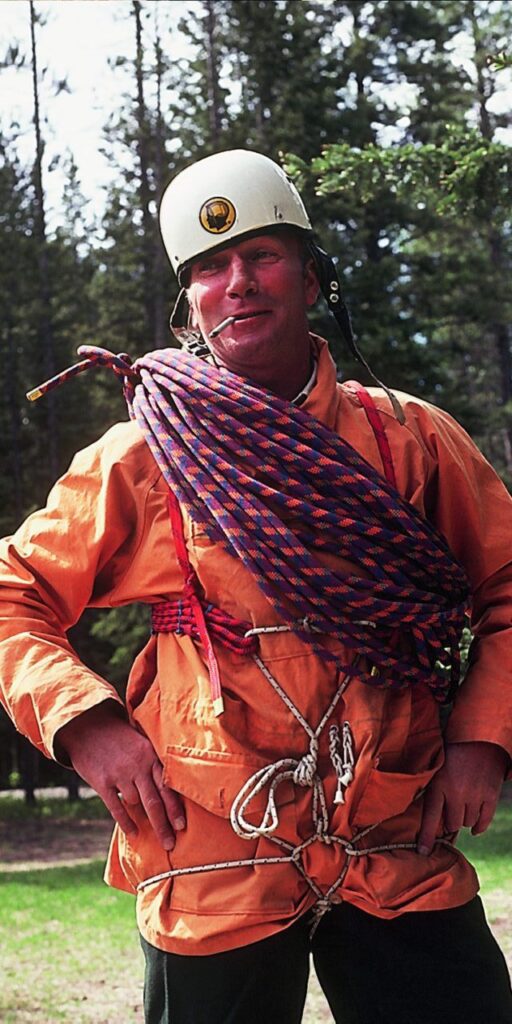
John Wackerle 1976ish
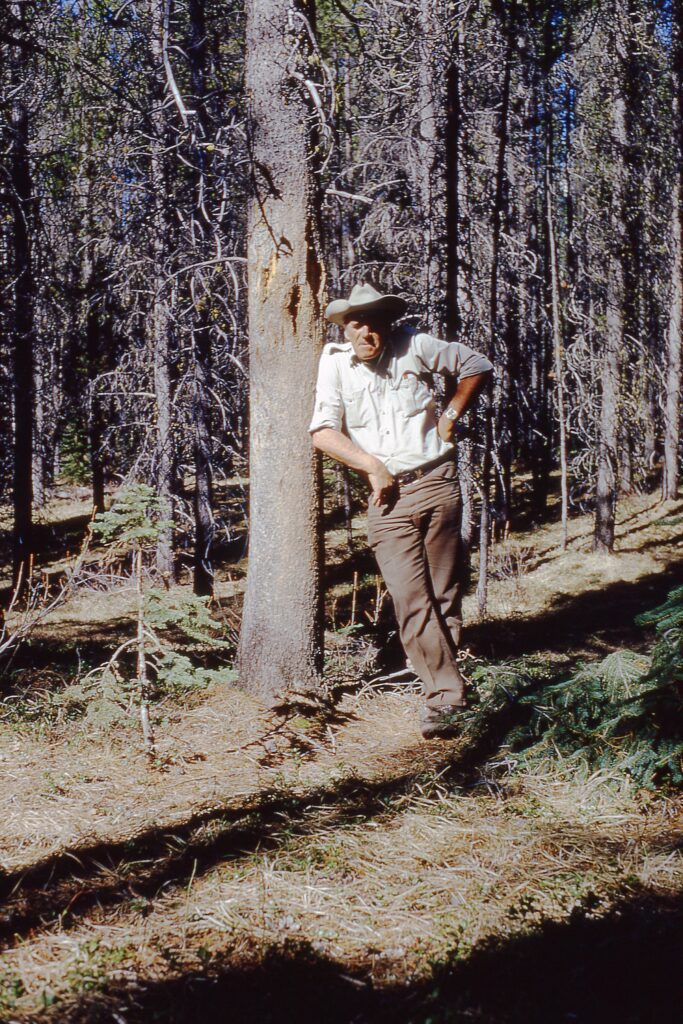
Bruno Engler 1973
1:16:05
Pete Tasker had taken volumes of pictures decades before, and they were in the basement of the Warden Office. Sometimes when there was nothing on the go, I’d go down and get the boxes and bring them up to Deegan. He knew all the people and places. He’d seen most of the park over time, even though he was never a senior warden. He was kind of the brunt of the jokes and a lot of the old guys had Deegan stories coming out the ying yang. He developed severe Parkinson’s, sometimes by the end of his shift he had a bruised face from his phone banging against his cheek. He was one of the first ones where they actually opened up a skull and probed around inside his brain. He was a real resource, he just knew so much and knew all the old guys Sam Evans, Erling Strom. If I would have been there 10 years earlier, I would have been lucky enough to known a lot of these guys.
My favorite horse was Monte because he was a walleyed horse. He had one blue eye and everything else and he had a mind of his own. He bucked Andy Anderson off at Scotch Camp whenever Andy got careless. He bucked me off if I wasn’t paying attention. I had him in the corral at Trail Center one time and he got up in the morning and he jumped out of the corral. It was a genuine four-foot high fence. He decided he didn’t want to go up to the Palliser that day. I had the stock truck with me so I saw his horse tracks in the mud headed for Banff and I headed that way in the stock truck and picked him up at 16 Mile. He just walked into the back of the truck as if nothing happened. I drove him all the way to Banff went and got some more groceries and a box of beer, then drove him all the way back to the Trail Center and said, “You didn’t get to go to Banff after all and now you’re going to be tied up all night.” He was a real character of a horse and you had to be alert with him.
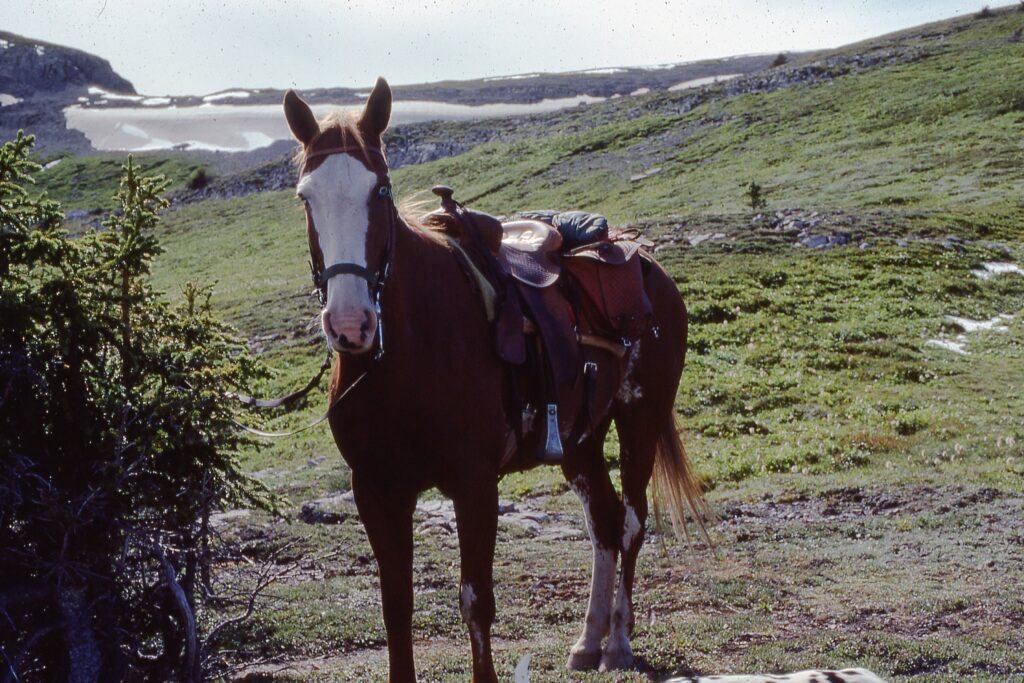
Monte the horse.
Favorite cabin was Bryant Creek because it was on the meadow and had the sunrise and had the bathtub at the back, so on a hot summer day I filled it up the day before. Some of the cabins didn’t have great location or they’d be in the dark. Cuthead (cabin) was in a dark hole and the logs were not peeled, so it was full of flies when the stove was on. I have a picture of Lance at the Clearwater cabin. The walls are painted different colors because that was Jim Rimmer’s district Indian Head and Clearwater, and he’d come into stores to get paint. Ron Leighton would give him whatever leftover paint he had. I think the roof was pink and one wall was green and the other wall was blue and Rimmer was colorblind so he really didn’t care. He left a legacy of these strangely painted cabins.
MH: Do you ever miss being a Warden?
RK: I did until it changed so much than I thought I couldn’t go back in. I still carry a folding saw in my pack everywhere I go. Sometimes I carry my little army shovel to do water bars and rehab trail work. I cleared the trail up to Paget lookout a few years ago, and the very next year Lake Louise ski hill got fined a million dollars for cutting down white bark pine trees. I dodged a bullet!
MH: Do you have any photos of yourself as a warden that you would like to donate? Artifacts?
RK: I have a bunch and will email them.
MH: What year did you retire? 1:25:45
RK: 1994 Freedom 45, foolishly I took my pension out and lost most of it in the stock market. It might as well have been the Livestock market. Shortly after that was when all the shit hit the fan about carrying side arms and the big high intensity summer prescribed burns and further re-organization. I was just as happy not to be there. I guess that I was too old fashioned for the new park system.
MH: What do you enjoy doing in retirement? 1:26:32:
RK: 20 years as a Marriage Commissioner and I did a lot of outdoor weddings. I avoided the big ones. I didn’t like when you had a whole bunch of bridesmaids telling you what was going happen and everything. So I just didn’t do them. I stuck to the Hoodoo Viewpoint and the helicopter open alpine with Lance Cooper as pilot. That was great fun. By 2017 it was getting so busy in the park that one could not find a place with a sense of occasion. Sunrise at Moraine Lake was impossible. People were filling up all of the accessible classic locations. I kind of gave up and said that’s enough of doing that for 20 years. I had the golden years of marriage commissioner so that was that. Now I have no schedule, I can just scramble and ski, and I try to do 50,000 vertical meters every summer. That means I’m out on rainy days, not just sunny days.
I’ve been around the world a few times in my life, but for the last five years we keep going at the same place in Mexico. It is really laid back and it doesn’t have any franchise hotels nor any franchise businesses. It’s just this little piece of Old Mexico. When we first started going there, there were still donkeys in the streets. you could do a yoga retreat and wake up at dawn to do noble silence for an hour with the roosters crowing the donkeys braying. We thought this is just its own little old time paradise. It is Mexico’s only official nude beach, which means it’s not crowded except at Christmas time. It is a little town with lots of independent operators. We’ve been kind of stuck doing that and we should travel more. But Maureen has chickens and the dog and the cats and the horses out at the ranch. It’s hard to find a critter sitter for more than two months at a time. That’s a bit of a draw back. Sepp Renner and I have been taking two or three week trips to Mexico and South America to scramble up the high volcanos in February, when it is still too cold to ski here.
MH: Is there anything I haven’t asked you that you think I should know about the Warden Service?
RK: I don’t think so. After I quit the Warden Service I played wildlife consultant for Skiing Louise and Marmot Basin for a few years. But then I got tired of banging my head against the wall because nobody wanted to hear that ski areas in the summertime were like avalanche paths and the berries grew in abundance. They had more moisture and the bears were happy there. They were advantageous for bears. But no one wanted to hear the good news, they just wanted to hear the stresses, so I got tired of doing that.
I had a nice position with Mike Wiegele for 10 years, looking after the wildlife reporting program, for Mike Wigele Heli Skiing; setting it up for him and then keeping the guides onboard, so I got free heli skiing which was a bonus. Then I got tired of banging my head against the BC biologists. We had all this animal reaction documented. Pictures of 212 helicopters with caribou asleep below them; and pictures of goats sleeping on ledges with a 21 hovering nearby. Because they flew so consistently, the animals were completely used to the helicopter traffic. Nobody did outrageous flying there. They didn’t mess around because they’re economizing the flights. The wildlife just adapted to them. That was another great news story.
Working with Alpine Helicopters in Canmore I attend talks with Alberta Parks and numerous helicopter operators to review flight protocol. I presented dozens of photos of bighorn sheep in Mt Charles Stewart basin oblivious to helicopter activity, and goat and caribou reaction that we had documented in heli-skiing with Mike Wiegele. The biologists at the meeting refused to believe what they were seeing. It was all “anecdotal” evidence, not science! Nor did we have any statistics. Their response was “ Well, they’re not really doing that”. I’m saying, “John, look, there’s a little kid asleep. There’s a goat facing the helicopter, laying down and another sleeping! They are totally calm.” The same thing with the BC Fish and Wildlife people. The ones that were on the power trips. They’d say, Well, that’s anecdotal, that’s not true. And that’s this and that. And so, it was good heli-skiing, but after a while I said, “Mike, for all I’m doing here, we might as well just have one of your young guides take over, because I can’t do anything more. So I stopped doing that. Now I just play. Maureen has a lot of overgrown spruce and willow on her ranch, so I am fire smarting her place.
MH: Anyone else to interview?
RK: I assume you have interviewed Peter Fuhrman, but maybe you’ve missed John Kellas. He just retired a few years ago and he has a perspective that goes back a long time. I think it goes right back into the late or middle 1980s. I remember chasing elk around town with him. He’s a bit of a loose cannon and he likes to talk a lot, but I’m sure he’s got an interesting perspective.
MH: Any final comments?
RK: I think we have it covered.
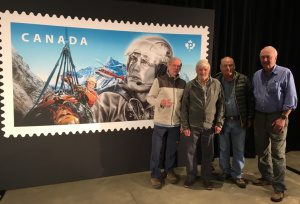
Rescue Stamp unveiled. Kiwi Gallagher, Lance Cooper ?? Jim Davies
